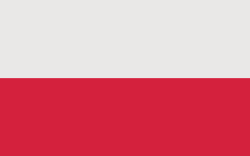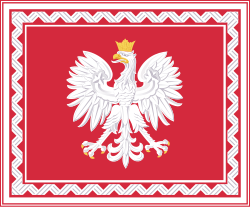| Type |
Image |
Symbol |
|---|
| National animal |
 |
The European bison (Bison bonasus) is one of the national animals of Poland. |
 |
The White stork (Ciconia ciconia) has a long history with Poland and is believed to be one of the national animals of the country. |
 |
Poland's enduring national symbol has been the white-tailed eagle (Haliaeetus albicilla), shown in the coat of arms.[11][12] |
| National mottos |
 |
Poland has no official motto of the State, namely the one which is recognised as such by the Polish national law. However, there are some common phrases which appear commonly on banners, flags and other symbols of the Polish state. One of the most common of such unofficial mottos is Za wolność Naszą i Waszą ("For our freedom and yours").[13] Another one is Bóg, Honor, Ojczyzna ("God, Honour, Fatherland").[14] During the times of the Polish–Lithuanian Commonwealth, the Latin expression Pro Fide, Lege et Rege ("For Faith, Law and King") was in use.[15] |
| National bell |
 |
The Sigismund Bell (Dzwon Zygmunt or Dzwon Zygmunta). Named after King Sigismund I of Poland and cast in 1520, it hangs at Wawel Cathedral in Kraków. At present, it is the second-largest bell in the country and is rung only on special occasions. It is not automated and twelve individuals are required to manually swing it.[16] |
| Ethnonyms |
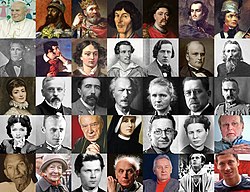 |
The ethnonyms for the Poles (people)[17] and Poland (their country)[18] include endonyms (the way Polish people refer to themselves and their country) and exonyms (the way other peoples refer to the Poles and their country). Endonyms and most exonyms for Poles and Poland derive from the name of a Lechitic tribe of Western Polans (Polanie), while in some languages the exonyms for Poland derive from the name of another tribe – the Lendians (Lędzianie).[19] The Polish words for a Pole are Polak (masculine) and Polka (feminine), Polki being the plural form for two or more women and Polacy being the plural form for the rest. The adjective "Polish" translates to Polish as polski (masculine), polska (feminine) and polskie (neuter). The common Polish name for Poland is Polska.[19] |
| Rzeczpospolita |
 |
The full official name of Poland is Rzeczpospolita Polska which loosely translates as "Republic of Poland". The word rzeczpospolita ("pospolita" - common and "rzecz" - an item signifying wealth, hence Commonwealth) has been used in Poland since at least the 16th century, originally a generic term to denote any state with a republican or similar form of government. Today, however, the word is used almost solely in reference to the Polish state.[20] |
| National personification |
 |
Polonia, the name for Poland in Latin and many Romance and other languages, is most often used in modern Polish as referring to the Polish diaspora. However it was also used as a national personification or the symbolic depiction of Poland as a woman called by the Latin name of that country was common in the 19th century. This is exemplified in Jan Matejko's painting Polonia, depicting the aftermath of the failed January 1863 Uprising, one of the most patriotic and symbolic paintings by Matejko.[21] Other personifications of Poland were created by artists like Stanisław Wyspiański and Jacek Malczewski. |
| National tree |
 |
Pedunculate oak (Quercus robur) |
| National flower |
 |
Red poppy (Papaver rhoeas) |
| National costume |
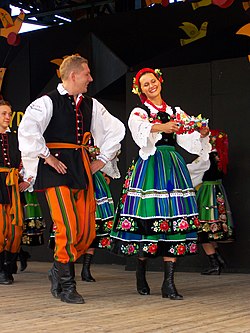 |
Polish traditional clothing |
| National hat |
 |
Rogatywka |
| National mountains |
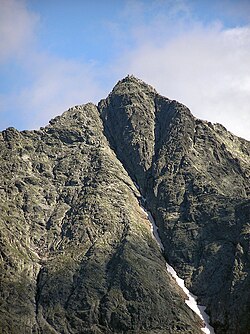 |
Rysy (2,501 m) or Giewont (1,894m)[22] |
| National river |
 |
Vistula (Polish: Wisła) |
| National dance |
 |
Polish folk dances are a tradition rooted in ten centuries of Polish culture and history. The Polish national dances are the Krakowiak, Kujawiak, Mazurek, Oberek, and Polonaise. These dances are classified as National, because almost every region in Poland has displayed a variety of these dances. |
| National fruit |
 |
Apple (Malus domestica) |
| National beverage |
 |
Vodka (Polish: wódka, gorzała, okowita) |
 |
Polish mead (Polish: miód pitny) is an alcoholic beverage within Polish culinary tradition made by alcoholic fermentation of a mixture of honey and water. It has a characteristic honey aroma and a flavour that may be enriched by the addition of fruit juices, herbs or spices. The colour ranges from golden to dark amber, depending on the type of honey used for production.[23] |
| National dish |
 |
Bigos, a hunters' stew made with cabbage and various kinds of meat. As with several other Polish foods, it is traditionally served in a bread bowl; it is served on Christmas Day and serves as one of the most important and oldest dishes of Polish cuisine, considered by some as the national dish. |
 |
Pierogi (singular: pieróg) are Polish dumplings that can have various savoury or sweet fillings, and are known as an enduring symbol of Polish national cuisine both in Poland and among Polish diaspora. Pierogi ruskie (Ruthenian pierogi), originating in south-east Poland (historically known as Red Ruthenia or Galicia) are considered by many Poles as the national dish. |
